Evaluating IFRS and GAAP for Jaunty Coffee Company's Financials
VerifiedAdded on 2023/04/23
|12
|3243
|462
Report
AI Summary
This report analyzes the differences and similarities between IFRS and US GAAP accounting standards, focusing on their application to Jaunty Coffee Company's financial statements. It examines the impact of various items, such as impairments, available-for-sale securities, and inventory valuation methods (LIFO vs. FIFO), on the balance sheet. The report justifies the continued use of GAAP for Jaunty Coffee Company, highlighting the tax implications and operational advantages over switching to IFRS. Key considerations include the treatment of intangible assets, the capitalization of development costs, and the classification of liabilities. Ultimately, the report advises the board of directors to maintain GAAP due to its favorable impact on the company's financial performance and tax liabilities. The document is available on Desklib, a platform providing study tools and resources for students.
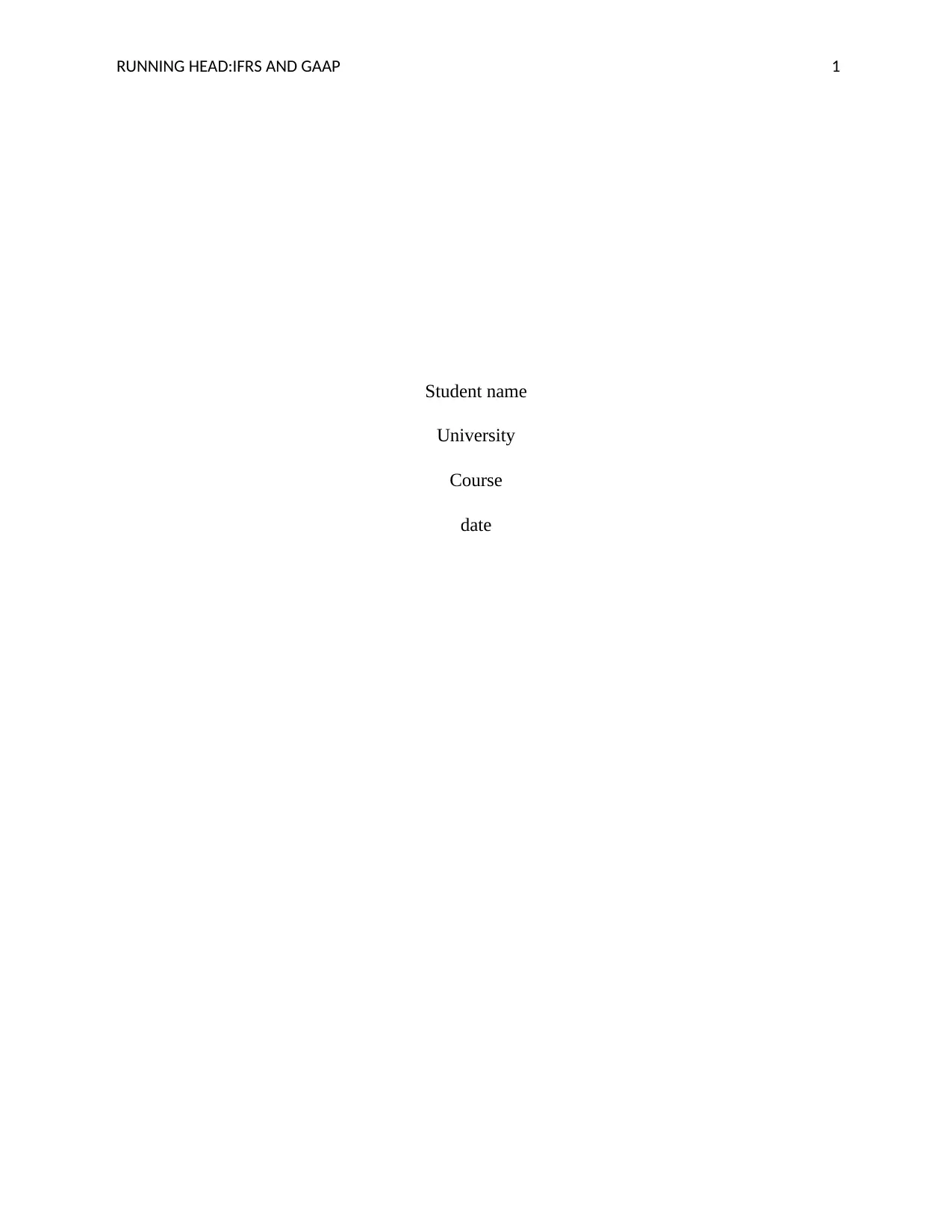
RUNNING HEAD:IFRS AND GAAP 1
Student name
University
Course
date
Student name
University
Course
date
Paraphrase This Document
Need a fresh take? Get an instant paraphrase of this document with our AI Paraphraser
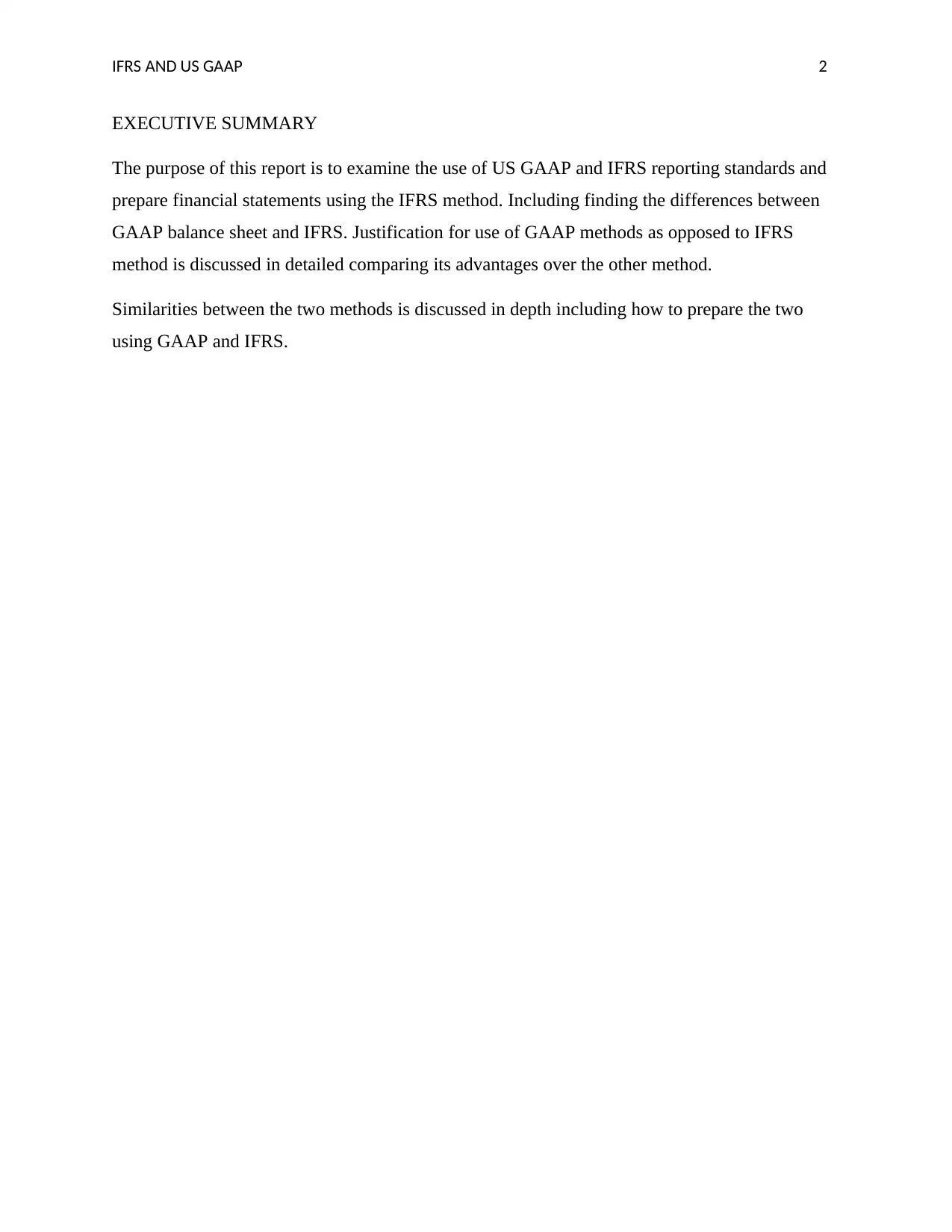
IFRS AND US GAAP 2
EXECUTIVE SUMMARY
The purpose of this report is to examine the use of US GAAP and IFRS reporting standards and
prepare financial statements using the IFRS method. Including finding the differences between
GAAP balance sheet and IFRS. Justification for use of GAAP methods as opposed to IFRS
method is discussed in detailed comparing its advantages over the other method.
Similarities between the two methods is discussed in depth including how to prepare the two
using GAAP and IFRS.
EXECUTIVE SUMMARY
The purpose of this report is to examine the use of US GAAP and IFRS reporting standards and
prepare financial statements using the IFRS method. Including finding the differences between
GAAP balance sheet and IFRS. Justification for use of GAAP methods as opposed to IFRS
method is discussed in detailed comparing its advantages over the other method.
Similarities between the two methods is discussed in depth including how to prepare the two
using GAAP and IFRS.
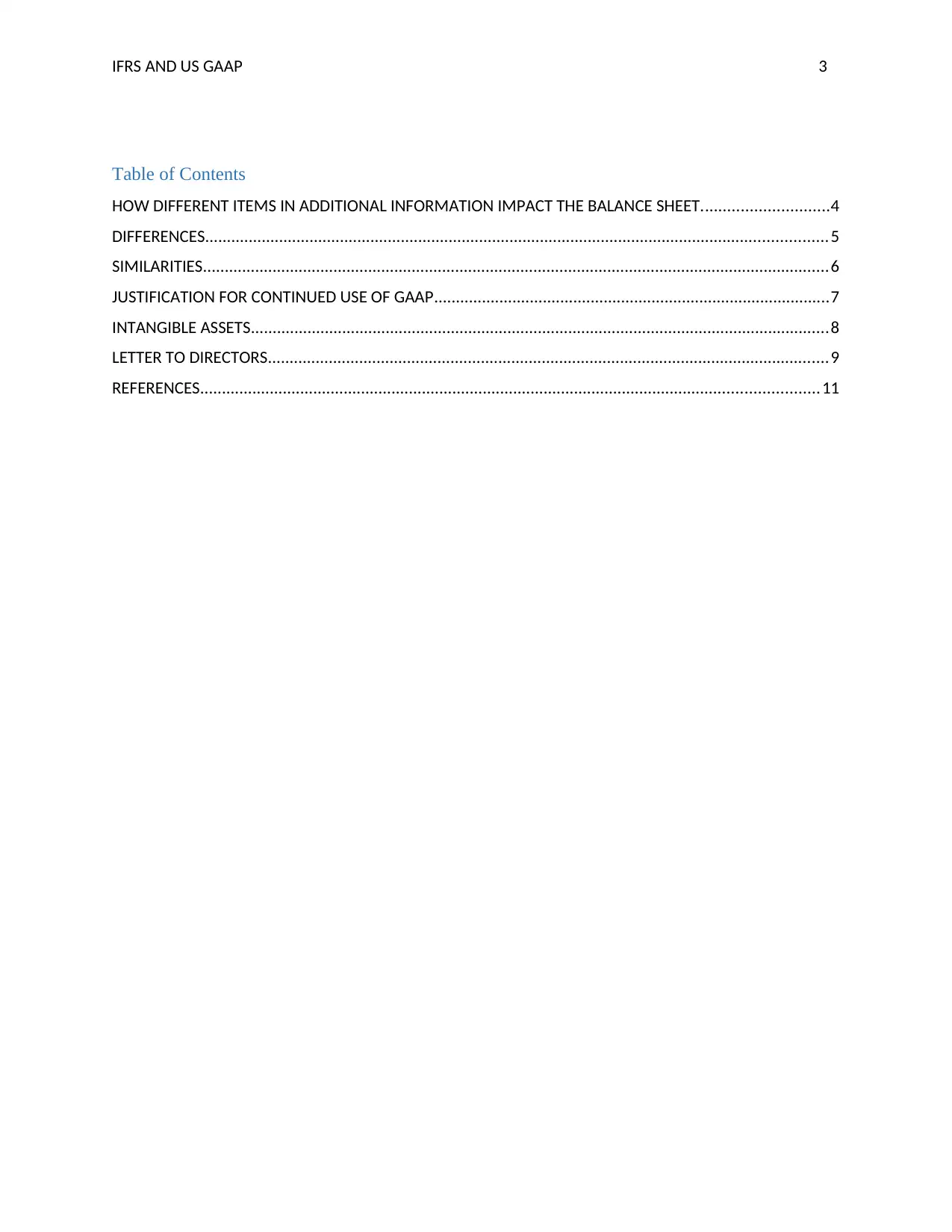
IFRS AND US GAAP 3
Table of Contents
HOW DIFFERENT ITEMS IN ADDITIONAL INFORMATION IMPACT THE BALANCE SHEET.............................4
DIFFERENCES...............................................................................................................................................5
SIMILARITIES................................................................................................................................................6
JUSTIFICATION FOR CONTINUED USE OF GAAP...........................................................................................7
INTANGIBLE ASSETS.....................................................................................................................................8
LETTER TO DIRECTORS.................................................................................................................................9
REFERENCES..............................................................................................................................................11
Table of Contents
HOW DIFFERENT ITEMS IN ADDITIONAL INFORMATION IMPACT THE BALANCE SHEET.............................4
DIFFERENCES...............................................................................................................................................5
SIMILARITIES................................................................................................................................................6
JUSTIFICATION FOR CONTINUED USE OF GAAP...........................................................................................7
INTANGIBLE ASSETS.....................................................................................................................................8
LETTER TO DIRECTORS.................................................................................................................................9
REFERENCES..............................................................................................................................................11
⊘ This is a preview!⊘
Do you want full access?
Subscribe today to unlock all pages.

Trusted by 1+ million students worldwide
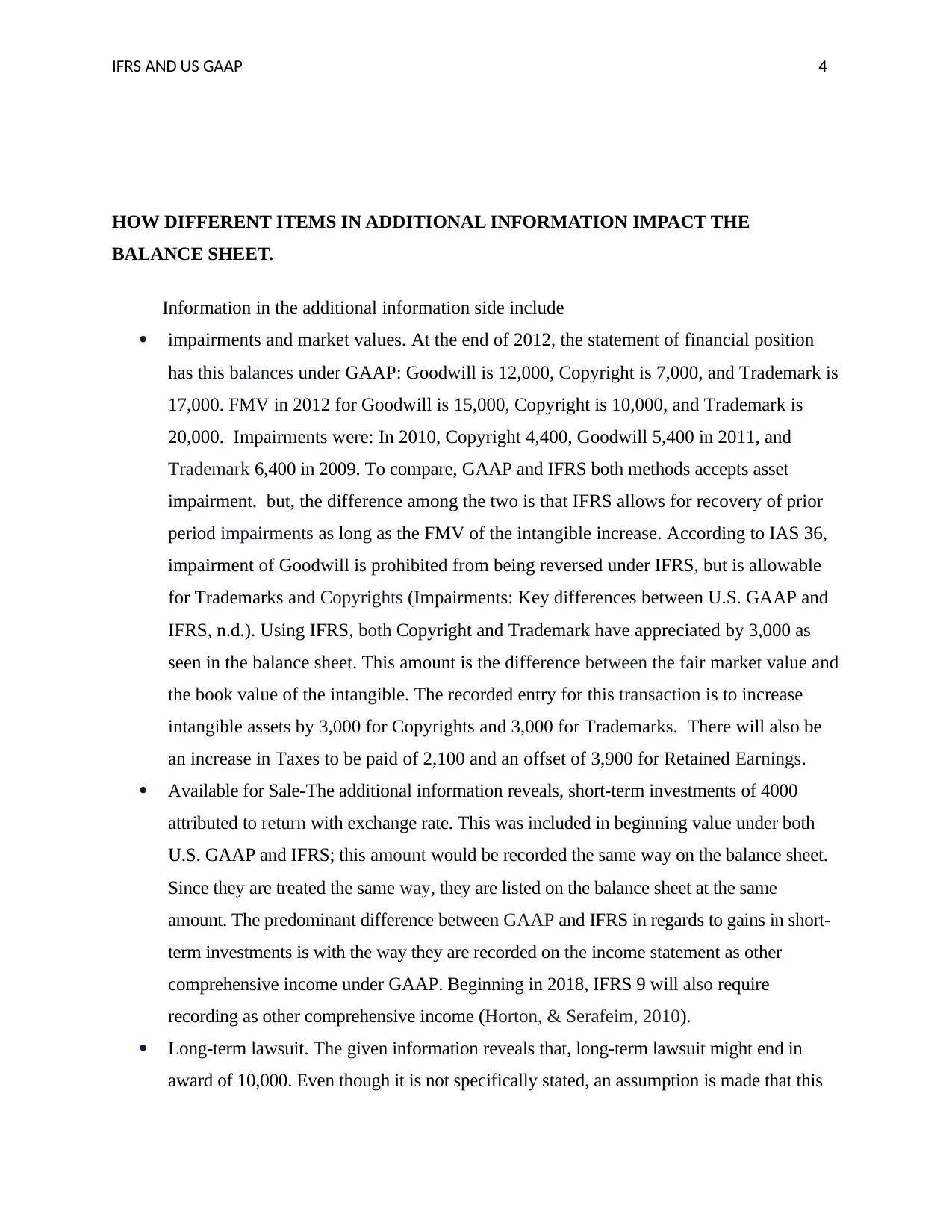
IFRS AND US GAAP 4
HOW DIFFERENT ITEMS IN ADDITIONAL INFORMATION IMPACT THE
BALANCE SHEET.
Information in the additional information side include
impairments and market values. At the end of 2012, the statement of financial position
has this balances under GAAP: Goodwill is 12,000, Copyright is 7,000, and Trademark is
17,000. FMV in 2012 for Goodwill is 15,000, Copyright is 10,000, and Trademark is
20,000. Impairments were: In 2010, Copyright 4,400, Goodwill 5,400 in 2011, and
Trademark 6,400 in 2009. To compare, GAAP and IFRS both methods accepts asset
impairment. but, the difference among the two is that IFRS allows for recovery of prior
period impairments as long as the FMV of the intangible increase. According to IAS 36,
impairment of Goodwill is prohibited from being reversed under IFRS, but is allowable
for Trademarks and Copyrights (Impairments: Key differences between U.S. GAAP and
IFRS, n.d.). Using IFRS, both Copyright and Trademark have appreciated by 3,000 as
seen in the balance sheet. This amount is the difference between the fair market value and
the book value of the intangible. The recorded entry for this transaction is to increase
intangible assets by 3,000 for Copyrights and 3,000 for Trademarks. There will also be
an increase in Taxes to be paid of 2,100 and an offset of 3,900 for Retained Earnings.
Available for Sale-The additional information reveals, short-term investments of 4000
attributed to return with exchange rate. This was included in beginning value under both
U.S. GAAP and IFRS; this amount would be recorded the same way on the balance sheet.
Since they are treated the same way, they are listed on the balance sheet at the same
amount. The predominant difference between GAAP and IFRS in regards to gains in short-
term investments is with the way they are recorded on the income statement as other
comprehensive income under GAAP. Beginning in 2018, IFRS 9 will also require
recording as other comprehensive income (Horton, & Serafeim, 2010).
Long-term lawsuit. The given information reveals that, long-term lawsuit might end in
award of 10,000. Even though it is not specifically stated, an assumption is made that this
HOW DIFFERENT ITEMS IN ADDITIONAL INFORMATION IMPACT THE
BALANCE SHEET.
Information in the additional information side include
impairments and market values. At the end of 2012, the statement of financial position
has this balances under GAAP: Goodwill is 12,000, Copyright is 7,000, and Trademark is
17,000. FMV in 2012 for Goodwill is 15,000, Copyright is 10,000, and Trademark is
20,000. Impairments were: In 2010, Copyright 4,400, Goodwill 5,400 in 2011, and
Trademark 6,400 in 2009. To compare, GAAP and IFRS both methods accepts asset
impairment. but, the difference among the two is that IFRS allows for recovery of prior
period impairments as long as the FMV of the intangible increase. According to IAS 36,
impairment of Goodwill is prohibited from being reversed under IFRS, but is allowable
for Trademarks and Copyrights (Impairments: Key differences between U.S. GAAP and
IFRS, n.d.). Using IFRS, both Copyright and Trademark have appreciated by 3,000 as
seen in the balance sheet. This amount is the difference between the fair market value and
the book value of the intangible. The recorded entry for this transaction is to increase
intangible assets by 3,000 for Copyrights and 3,000 for Trademarks. There will also be
an increase in Taxes to be paid of 2,100 and an offset of 3,900 for Retained Earnings.
Available for Sale-The additional information reveals, short-term investments of 4000
attributed to return with exchange rate. This was included in beginning value under both
U.S. GAAP and IFRS; this amount would be recorded the same way on the balance sheet.
Since they are treated the same way, they are listed on the balance sheet at the same
amount. The predominant difference between GAAP and IFRS in regards to gains in short-
term investments is with the way they are recorded on the income statement as other
comprehensive income under GAAP. Beginning in 2018, IFRS 9 will also require
recording as other comprehensive income (Horton, & Serafeim, 2010).
Long-term lawsuit. The given information reveals that, long-term lawsuit might end in
award of 10,000. Even though it is not specifically stated, an assumption is made that this
Paraphrase This Document
Need a fresh take? Get an instant paraphrase of this document with our AI Paraphraser
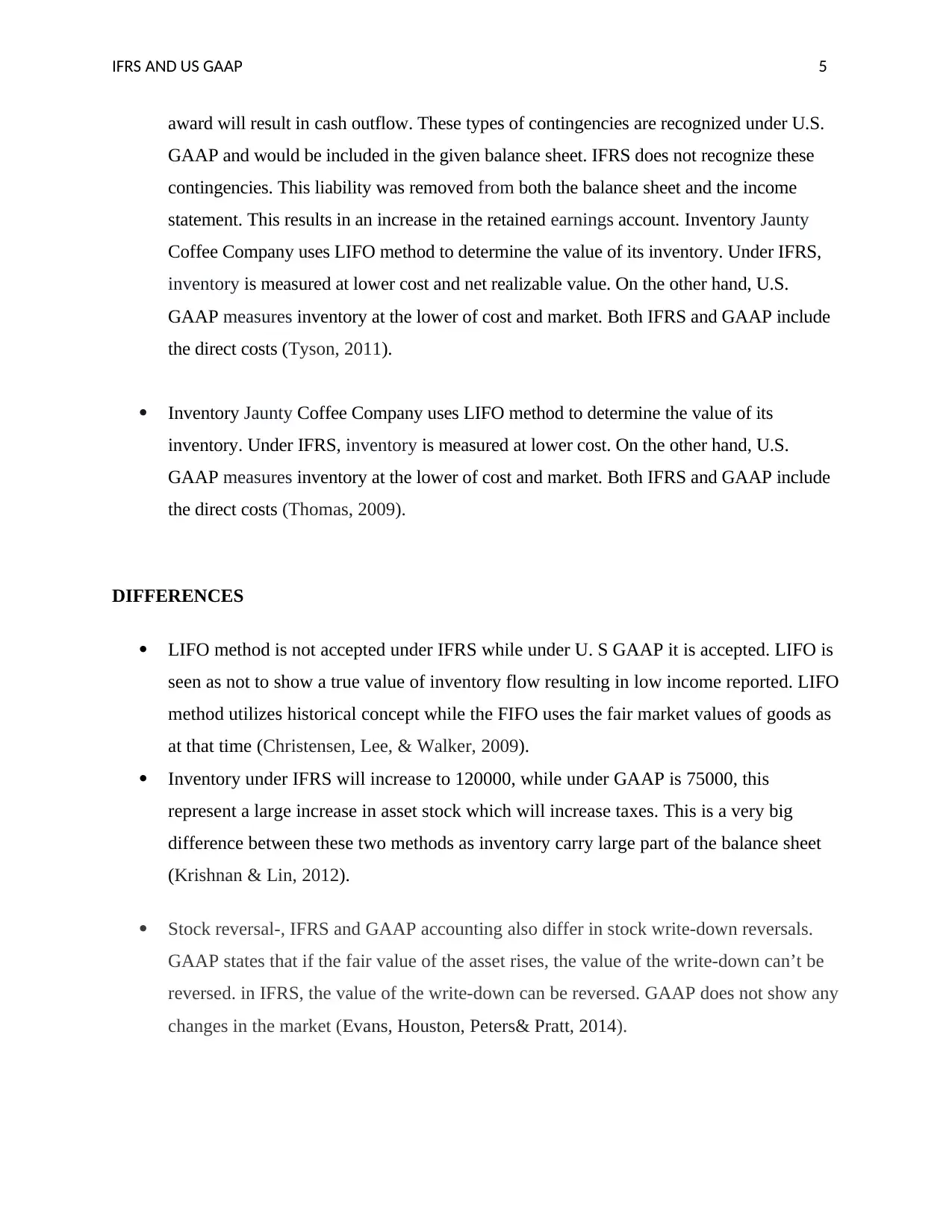
IFRS AND US GAAP 5
award will result in cash outflow. These types of contingencies are recognized under U.S.
GAAP and would be included in the given balance sheet. IFRS does not recognize these
contingencies. This liability was removed from both the balance sheet and the income
statement. This results in an increase in the retained earnings account. Inventory Jaunty
Coffee Company uses LIFO method to determine the value of its inventory. Under IFRS,
inventory is measured at lower cost and net realizable value. On the other hand, U.S.
GAAP measures inventory at the lower of cost and market. Both IFRS and GAAP include
the direct costs (Tyson, 2011).
Inventory Jaunty Coffee Company uses LIFO method to determine the value of its
inventory. Under IFRS, inventory is measured at lower cost. On the other hand, U.S.
GAAP measures inventory at the lower of cost and market. Both IFRS and GAAP include
the direct costs (Thomas, 2009).
DIFFERENCES
LIFO method is not accepted under IFRS while under U. S GAAP it is accepted. LIFO is
seen as not to show a true value of inventory flow resulting in low income reported. LIFO
method utilizes historical concept while the FIFO uses the fair market values of goods as
at that time (Christensen, Lee, & Walker, 2009).
Inventory under IFRS will increase to 120000, while under GAAP is 75000, this
represent a large increase in asset stock which will increase taxes. This is a very big
difference between these two methods as inventory carry large part of the balance sheet
(Krishnan & Lin, 2012).
Stock reversal-, IFRS and GAAP accounting also differ in stock write-down reversals.
GAAP states that if the fair value of the asset rises, the value of the write-down can’t be
reversed. in IFRS, the value of the write-down can be reversed. GAAP does not show any
changes in the market (Evans, Houston, Peters& Pratt, 2014).
award will result in cash outflow. These types of contingencies are recognized under U.S.
GAAP and would be included in the given balance sheet. IFRS does not recognize these
contingencies. This liability was removed from both the balance sheet and the income
statement. This results in an increase in the retained earnings account. Inventory Jaunty
Coffee Company uses LIFO method to determine the value of its inventory. Under IFRS,
inventory is measured at lower cost and net realizable value. On the other hand, U.S.
GAAP measures inventory at the lower of cost and market. Both IFRS and GAAP include
the direct costs (Tyson, 2011).
Inventory Jaunty Coffee Company uses LIFO method to determine the value of its
inventory. Under IFRS, inventory is measured at lower cost. On the other hand, U.S.
GAAP measures inventory at the lower of cost and market. Both IFRS and GAAP include
the direct costs (Thomas, 2009).
DIFFERENCES
LIFO method is not accepted under IFRS while under U. S GAAP it is accepted. LIFO is
seen as not to show a true value of inventory flow resulting in low income reported. LIFO
method utilizes historical concept while the FIFO uses the fair market values of goods as
at that time (Christensen, Lee, & Walker, 2009).
Inventory under IFRS will increase to 120000, while under GAAP is 75000, this
represent a large increase in asset stock which will increase taxes. This is a very big
difference between these two methods as inventory carry large part of the balance sheet
(Krishnan & Lin, 2012).
Stock reversal-, IFRS and GAAP accounting also differ in stock write-down reversals.
GAAP states that if the fair value of the asset rises, the value of the write-down can’t be
reversed. in IFRS, the value of the write-down can be reversed. GAAP does not show any
changes in the market (Evans, Houston, Peters& Pratt, 2014).
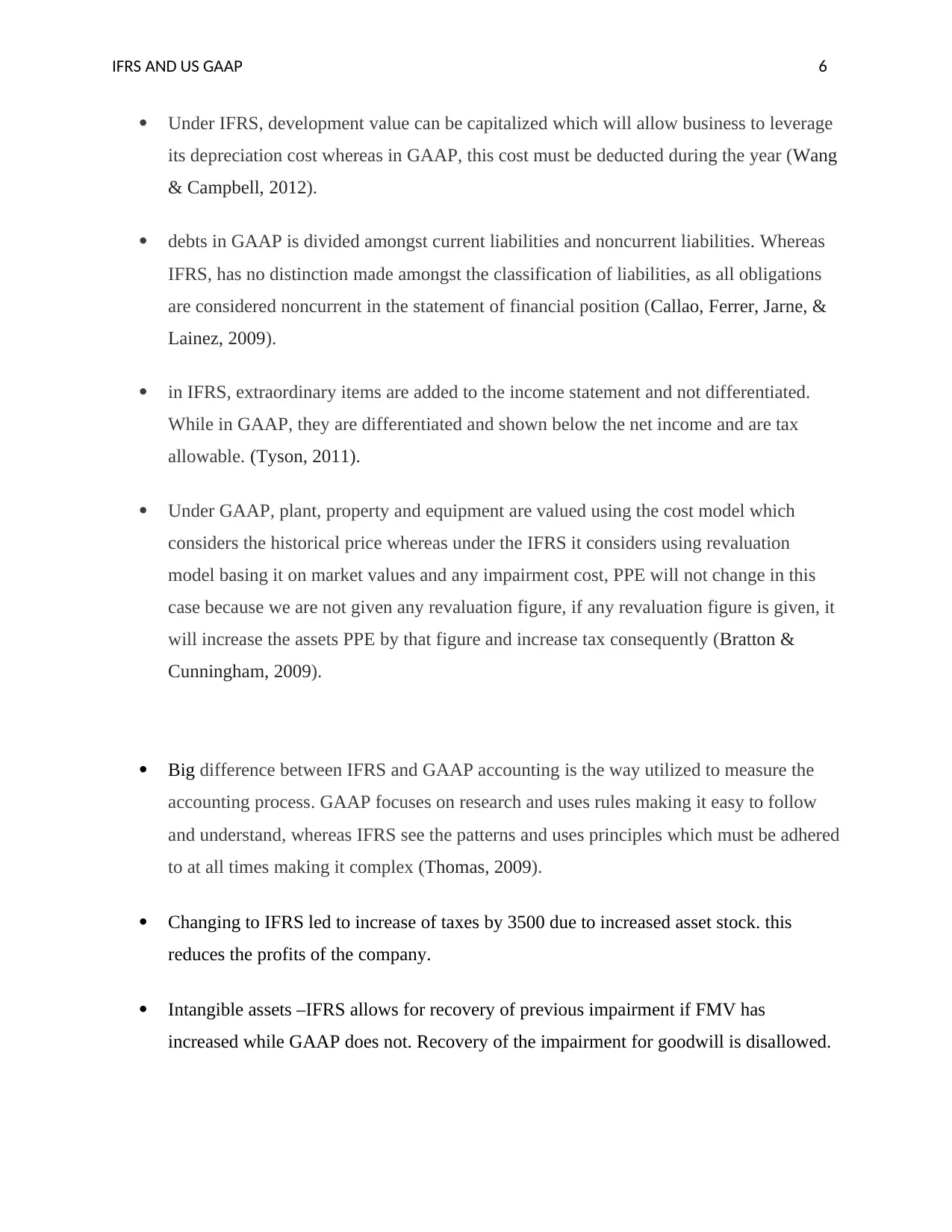
IFRS AND US GAAP 6
Under IFRS, development value can be capitalized which will allow business to leverage
its depreciation cost whereas in GAAP, this cost must be deducted during the year (Wang
& Campbell, 2012).
debts in GAAP is divided amongst current liabilities and noncurrent liabilities. Whereas
IFRS, has no distinction made amongst the classification of liabilities, as all obligations
are considered noncurrent in the statement of financial position (Callao, Ferrer, Jarne, &
Lainez, 2009).
in IFRS, extraordinary items are added to the income statement and not differentiated.
While in GAAP, they are differentiated and shown below the net income and are tax
allowable. (Tyson, 2011).
Under GAAP, plant, property and equipment are valued using the cost model which
considers the historical price whereas under the IFRS it considers using revaluation
model basing it on market values and any impairment cost, PPE will not change in this
case because we are not given any revaluation figure, if any revaluation figure is given, it
will increase the assets PPE by that figure and increase tax consequently (Bratton &
Cunningham, 2009).
Big difference between IFRS and GAAP accounting is the way utilized to measure the
accounting process. GAAP focuses on research and uses rules making it easy to follow
and understand, whereas IFRS see the patterns and uses principles which must be adhered
to at all times making it complex (Thomas, 2009).
Changing to IFRS led to increase of taxes by 3500 due to increased asset stock. this
reduces the profits of the company.
Intangible assets –IFRS allows for recovery of previous impairment if FMV has
increased while GAAP does not. Recovery of the impairment for goodwill is disallowed.
Under IFRS, development value can be capitalized which will allow business to leverage
its depreciation cost whereas in GAAP, this cost must be deducted during the year (Wang
& Campbell, 2012).
debts in GAAP is divided amongst current liabilities and noncurrent liabilities. Whereas
IFRS, has no distinction made amongst the classification of liabilities, as all obligations
are considered noncurrent in the statement of financial position (Callao, Ferrer, Jarne, &
Lainez, 2009).
in IFRS, extraordinary items are added to the income statement and not differentiated.
While in GAAP, they are differentiated and shown below the net income and are tax
allowable. (Tyson, 2011).
Under GAAP, plant, property and equipment are valued using the cost model which
considers the historical price whereas under the IFRS it considers using revaluation
model basing it on market values and any impairment cost, PPE will not change in this
case because we are not given any revaluation figure, if any revaluation figure is given, it
will increase the assets PPE by that figure and increase tax consequently (Bratton &
Cunningham, 2009).
Big difference between IFRS and GAAP accounting is the way utilized to measure the
accounting process. GAAP focuses on research and uses rules making it easy to follow
and understand, whereas IFRS see the patterns and uses principles which must be adhered
to at all times making it complex (Thomas, 2009).
Changing to IFRS led to increase of taxes by 3500 due to increased asset stock. this
reduces the profits of the company.
Intangible assets –IFRS allows for recovery of previous impairment if FMV has
increased while GAAP does not. Recovery of the impairment for goodwill is disallowed.
⊘ This is a preview!⊘
Do you want full access?
Subscribe today to unlock all pages.

Trusted by 1+ million students worldwide
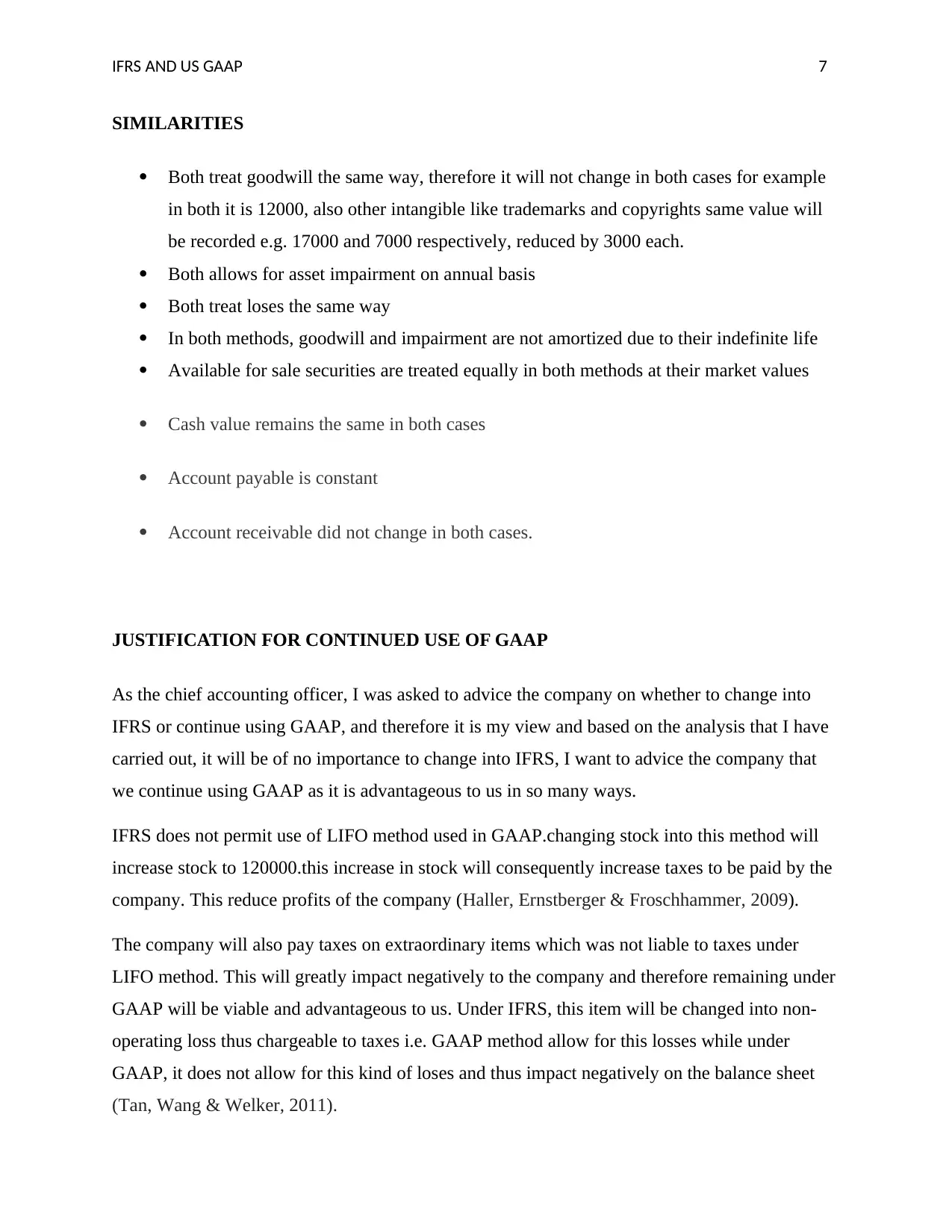
IFRS AND US GAAP 7
SIMILARITIES
Both treat goodwill the same way, therefore it will not change in both cases for example
in both it is 12000, also other intangible like trademarks and copyrights same value will
be recorded e.g. 17000 and 7000 respectively, reduced by 3000 each.
Both allows for asset impairment on annual basis
Both treat loses the same way
In both methods, goodwill and impairment are not amortized due to their indefinite life
Available for sale securities are treated equally in both methods at their market values
Cash value remains the same in both cases
Account payable is constant
Account receivable did not change in both cases.
JUSTIFICATION FOR CONTINUED USE OF GAAP
As the chief accounting officer, I was asked to advice the company on whether to change into
IFRS or continue using GAAP, and therefore it is my view and based on the analysis that I have
carried out, it will be of no importance to change into IFRS, I want to advice the company that
we continue using GAAP as it is advantageous to us in so many ways.
IFRS does not permit use of LIFO method used in GAAP.changing stock into this method will
increase stock to 120000.this increase in stock will consequently increase taxes to be paid by the
company. This reduce profits of the company (Haller, Ernstberger & Froschhammer, 2009).
The company will also pay taxes on extraordinary items which was not liable to taxes under
LIFO method. This will greatly impact negatively to the company and therefore remaining under
GAAP will be viable and advantageous to us. Under IFRS, this item will be changed into non-
operating loss thus chargeable to taxes i.e. GAAP method allow for this losses while under
GAAP, it does not allow for this kind of loses and thus impact negatively on the balance sheet
(Tan, Wang & Welker, 2011).
SIMILARITIES
Both treat goodwill the same way, therefore it will not change in both cases for example
in both it is 12000, also other intangible like trademarks and copyrights same value will
be recorded e.g. 17000 and 7000 respectively, reduced by 3000 each.
Both allows for asset impairment on annual basis
Both treat loses the same way
In both methods, goodwill and impairment are not amortized due to their indefinite life
Available for sale securities are treated equally in both methods at their market values
Cash value remains the same in both cases
Account payable is constant
Account receivable did not change in both cases.
JUSTIFICATION FOR CONTINUED USE OF GAAP
As the chief accounting officer, I was asked to advice the company on whether to change into
IFRS or continue using GAAP, and therefore it is my view and based on the analysis that I have
carried out, it will be of no importance to change into IFRS, I want to advice the company that
we continue using GAAP as it is advantageous to us in so many ways.
IFRS does not permit use of LIFO method used in GAAP.changing stock into this method will
increase stock to 120000.this increase in stock will consequently increase taxes to be paid by the
company. This reduce profits of the company (Haller, Ernstberger & Froschhammer, 2009).
The company will also pay taxes on extraordinary items which was not liable to taxes under
LIFO method. This will greatly impact negatively to the company and therefore remaining under
GAAP will be viable and advantageous to us. Under IFRS, this item will be changed into non-
operating loss thus chargeable to taxes i.e. GAAP method allow for this losses while under
GAAP, it does not allow for this kind of loses and thus impact negatively on the balance sheet
(Tan, Wang & Welker, 2011).
Paraphrase This Document
Need a fresh take? Get an instant paraphrase of this document with our AI Paraphraser
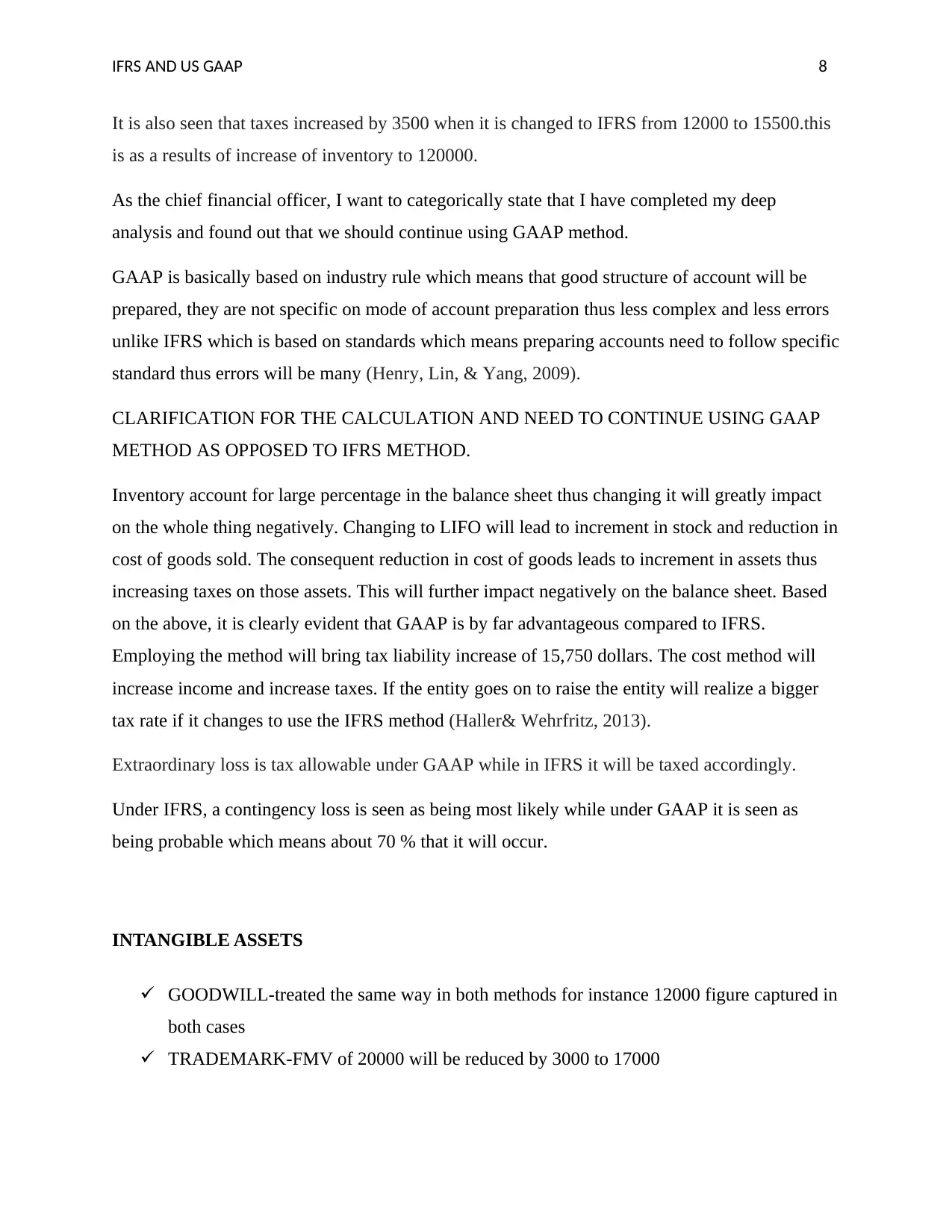
IFRS AND US GAAP 8
It is also seen that taxes increased by 3500 when it is changed to IFRS from 12000 to 15500.this
is as a results of increase of inventory to 120000.
As the chief financial officer, I want to categorically state that I have completed my deep
analysis and found out that we should continue using GAAP method.
GAAP is basically based on industry rule which means that good structure of account will be
prepared, they are not specific on mode of account preparation thus less complex and less errors
unlike IFRS which is based on standards which means preparing accounts need to follow specific
standard thus errors will be many (Henry, Lin, & Yang, 2009).
CLARIFICATION FOR THE CALCULATION AND NEED TO CONTINUE USING GAAP
METHOD AS OPPOSED TO IFRS METHOD.
Inventory account for large percentage in the balance sheet thus changing it will greatly impact
on the whole thing negatively. Changing to LIFO will lead to increment in stock and reduction in
cost of goods sold. The consequent reduction in cost of goods leads to increment in assets thus
increasing taxes on those assets. This will further impact negatively on the balance sheet. Based
on the above, it is clearly evident that GAAP is by far advantageous compared to IFRS.
Employing the method will bring tax liability increase of 15,750 dollars. The cost method will
increase income and increase taxes. If the entity goes on to raise the entity will realize a bigger
tax rate if it changes to use the IFRS method (Haller& Wehrfritz, 2013).
Extraordinary loss is tax allowable under GAAP while in IFRS it will be taxed accordingly.
Under IFRS, a contingency loss is seen as being most likely while under GAAP it is seen as
being probable which means about 70 % that it will occur.
INTANGIBLE ASSETS
GOODWILL-treated the same way in both methods for instance 12000 figure captured in
both cases
TRADEMARK-FMV of 20000 will be reduced by 3000 to 17000
It is also seen that taxes increased by 3500 when it is changed to IFRS from 12000 to 15500.this
is as a results of increase of inventory to 120000.
As the chief financial officer, I want to categorically state that I have completed my deep
analysis and found out that we should continue using GAAP method.
GAAP is basically based on industry rule which means that good structure of account will be
prepared, they are not specific on mode of account preparation thus less complex and less errors
unlike IFRS which is based on standards which means preparing accounts need to follow specific
standard thus errors will be many (Henry, Lin, & Yang, 2009).
CLARIFICATION FOR THE CALCULATION AND NEED TO CONTINUE USING GAAP
METHOD AS OPPOSED TO IFRS METHOD.
Inventory account for large percentage in the balance sheet thus changing it will greatly impact
on the whole thing negatively. Changing to LIFO will lead to increment in stock and reduction in
cost of goods sold. The consequent reduction in cost of goods leads to increment in assets thus
increasing taxes on those assets. This will further impact negatively on the balance sheet. Based
on the above, it is clearly evident that GAAP is by far advantageous compared to IFRS.
Employing the method will bring tax liability increase of 15,750 dollars. The cost method will
increase income and increase taxes. If the entity goes on to raise the entity will realize a bigger
tax rate if it changes to use the IFRS method (Haller& Wehrfritz, 2013).
Extraordinary loss is tax allowable under GAAP while in IFRS it will be taxed accordingly.
Under IFRS, a contingency loss is seen as being most likely while under GAAP it is seen as
being probable which means about 70 % that it will occur.
INTANGIBLE ASSETS
GOODWILL-treated the same way in both methods for instance 12000 figure captured in
both cases
TRADEMARK-FMV of 20000 will be reduced by 3000 to 17000
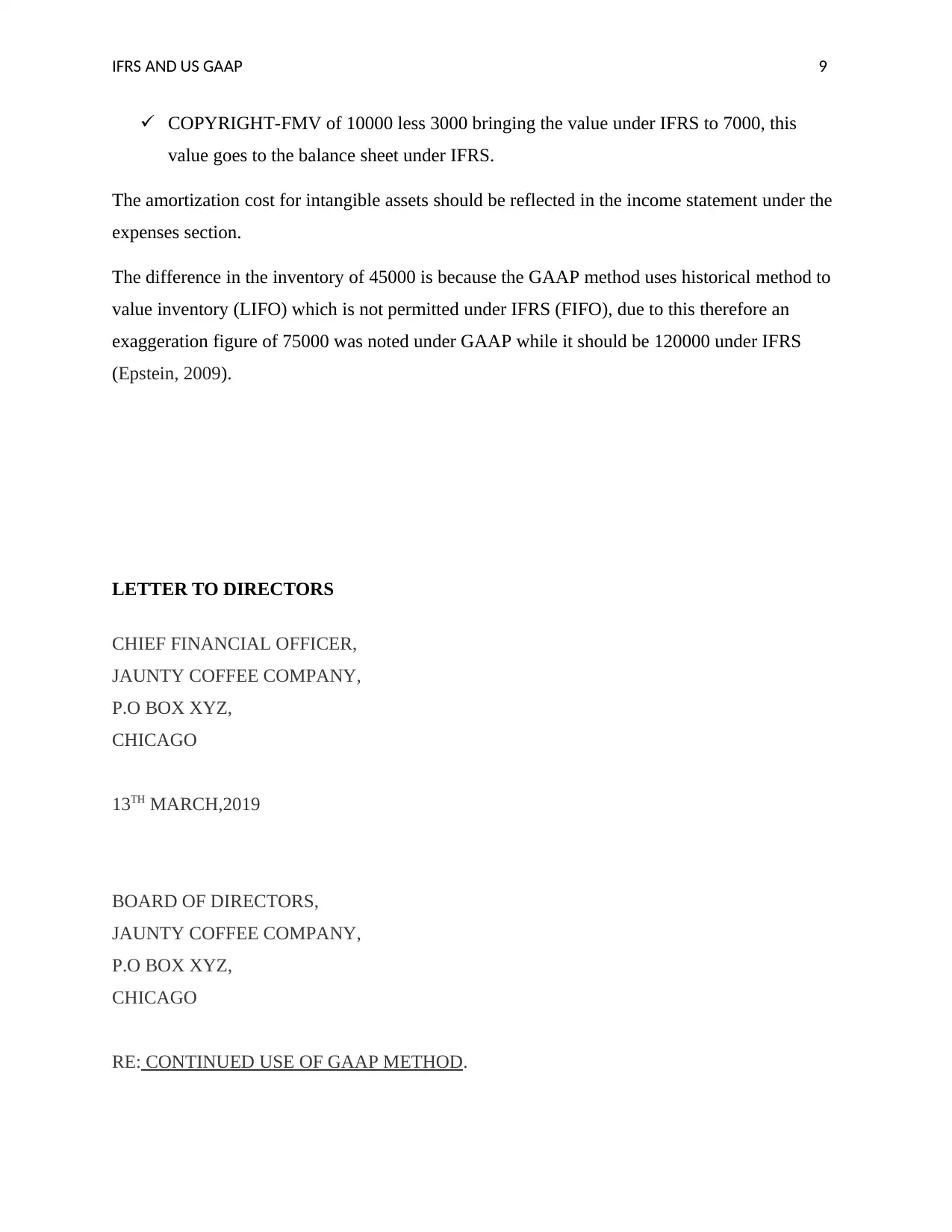
IFRS AND US GAAP 9
COPYRIGHT-FMV of 10000 less 3000 bringing the value under IFRS to 7000, this
value goes to the balance sheet under IFRS.
The amortization cost for intangible assets should be reflected in the income statement under the
expenses section.
The difference in the inventory of 45000 is because the GAAP method uses historical method to
value inventory (LIFO) which is not permitted under IFRS (FIFO), due to this therefore an
exaggeration figure of 75000 was noted under GAAP while it should be 120000 under IFRS
(Epstein, 2009).
LETTER TO DIRECTORS
CHIEF FINANCIAL OFFICER,
JAUNTY COFFEE COMPANY,
P.O BOX XYZ,
CHICAGO
13TH MARCH,2019
BOARD OF DIRECTORS,
JAUNTY COFFEE COMPANY,
P.O BOX XYZ,
CHICAGO
RE: CONTINUED USE OF GAAP METHOD.
COPYRIGHT-FMV of 10000 less 3000 bringing the value under IFRS to 7000, this
value goes to the balance sheet under IFRS.
The amortization cost for intangible assets should be reflected in the income statement under the
expenses section.
The difference in the inventory of 45000 is because the GAAP method uses historical method to
value inventory (LIFO) which is not permitted under IFRS (FIFO), due to this therefore an
exaggeration figure of 75000 was noted under GAAP while it should be 120000 under IFRS
(Epstein, 2009).
LETTER TO DIRECTORS
CHIEF FINANCIAL OFFICER,
JAUNTY COFFEE COMPANY,
P.O BOX XYZ,
CHICAGO
13TH MARCH,2019
BOARD OF DIRECTORS,
JAUNTY COFFEE COMPANY,
P.O BOX XYZ,
CHICAGO
RE: CONTINUED USE OF GAAP METHOD.
⊘ This is a preview!⊘
Do you want full access?
Subscribe today to unlock all pages.

Trusted by 1+ million students worldwide
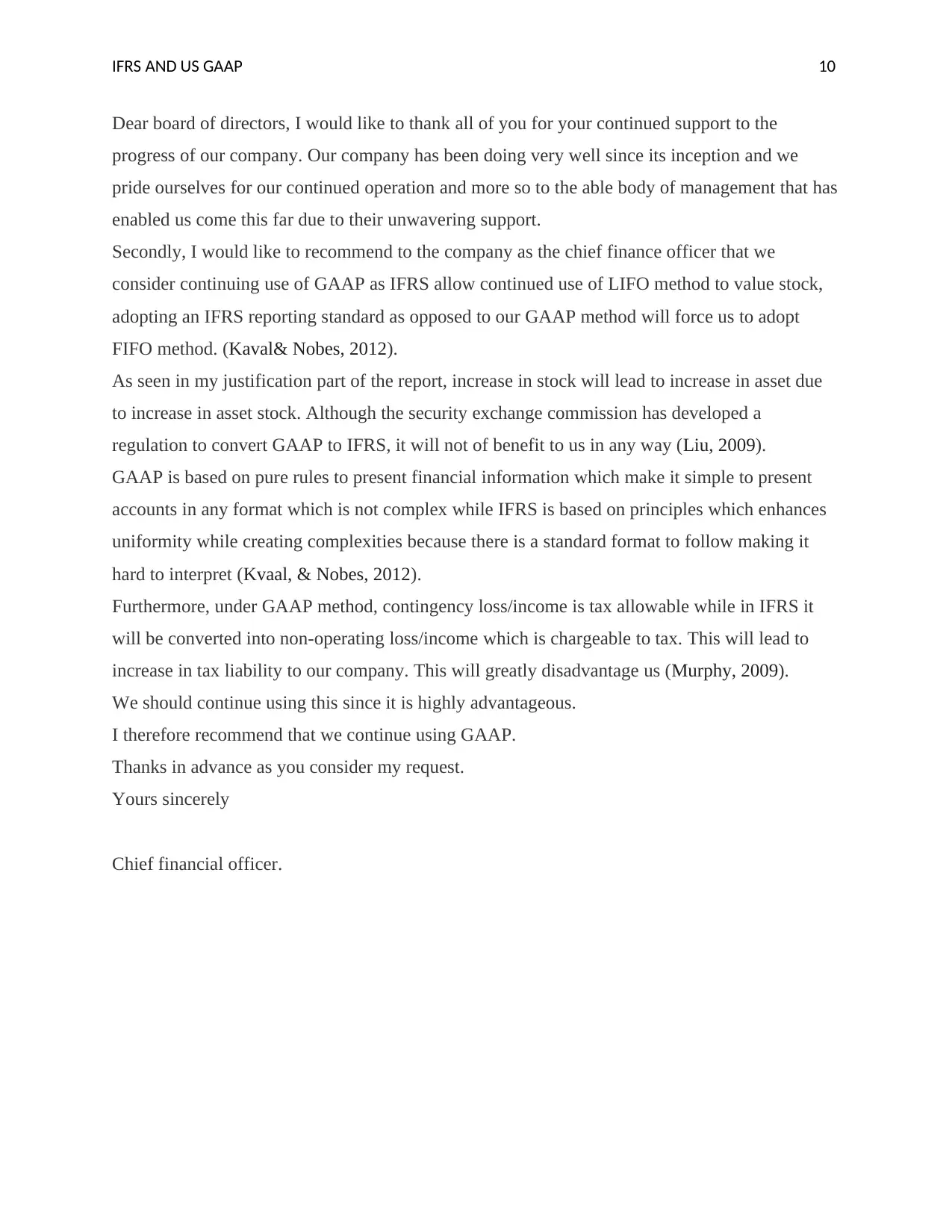
IFRS AND US GAAP 10
Dear board of directors, I would like to thank all of you for your continued support to the
progress of our company. Our company has been doing very well since its inception and we
pride ourselves for our continued operation and more so to the able body of management that has
enabled us come this far due to their unwavering support.
Secondly, I would like to recommend to the company as the chief finance officer that we
consider continuing use of GAAP as IFRS allow continued use of LIFO method to value stock,
adopting an IFRS reporting standard as opposed to our GAAP method will force us to adopt
FIFO method. (Kaval& Nobes, 2012).
As seen in my justification part of the report, increase in stock will lead to increase in asset due
to increase in asset stock. Although the security exchange commission has developed a
regulation to convert GAAP to IFRS, it will not of benefit to us in any way (Liu, 2009).
GAAP is based on pure rules to present financial information which make it simple to present
accounts in any format which is not complex while IFRS is based on principles which enhances
uniformity while creating complexities because there is a standard format to follow making it
hard to interpret (Kvaal, & Nobes, 2012).
Furthermore, under GAAP method, contingency loss/income is tax allowable while in IFRS it
will be converted into non-operating loss/income which is chargeable to tax. This will lead to
increase in tax liability to our company. This will greatly disadvantage us (Murphy, 2009).
We should continue using this since it is highly advantageous.
I therefore recommend that we continue using GAAP.
Thanks in advance as you consider my request.
Yours sincerely
Chief financial officer.
Dear board of directors, I would like to thank all of you for your continued support to the
progress of our company. Our company has been doing very well since its inception and we
pride ourselves for our continued operation and more so to the able body of management that has
enabled us come this far due to their unwavering support.
Secondly, I would like to recommend to the company as the chief finance officer that we
consider continuing use of GAAP as IFRS allow continued use of LIFO method to value stock,
adopting an IFRS reporting standard as opposed to our GAAP method will force us to adopt
FIFO method. (Kaval& Nobes, 2012).
As seen in my justification part of the report, increase in stock will lead to increase in asset due
to increase in asset stock. Although the security exchange commission has developed a
regulation to convert GAAP to IFRS, it will not of benefit to us in any way (Liu, 2009).
GAAP is based on pure rules to present financial information which make it simple to present
accounts in any format which is not complex while IFRS is based on principles which enhances
uniformity while creating complexities because there is a standard format to follow making it
hard to interpret (Kvaal, & Nobes, 2012).
Furthermore, under GAAP method, contingency loss/income is tax allowable while in IFRS it
will be converted into non-operating loss/income which is chargeable to tax. This will lead to
increase in tax liability to our company. This will greatly disadvantage us (Murphy, 2009).
We should continue using this since it is highly advantageous.
I therefore recommend that we continue using GAAP.
Thanks in advance as you consider my request.
Yours sincerely
Chief financial officer.
Paraphrase This Document
Need a fresh take? Get an instant paraphrase of this document with our AI Paraphraser
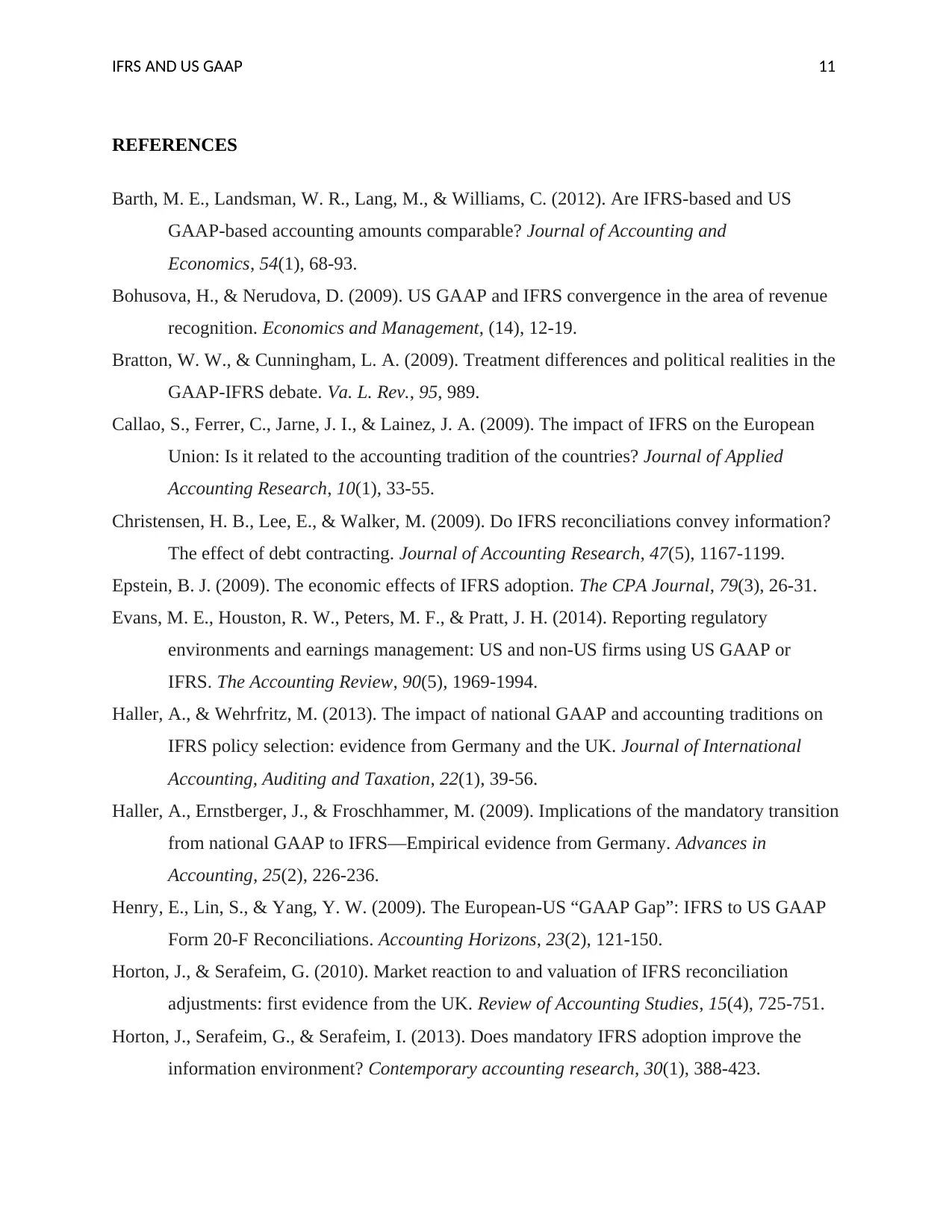
IFRS AND US GAAP 11
REFERENCES
Barth, M. E., Landsman, W. R., Lang, M., & Williams, C. (2012). Are IFRS-based and US
GAAP-based accounting amounts comparable? Journal of Accounting and
Economics, 54(1), 68-93.
Bohusova, H., & Nerudova, D. (2009). US GAAP and IFRS convergence in the area of revenue
recognition. Economics and Management, (14), 12-19.
Bratton, W. W., & Cunningham, L. A. (2009). Treatment differences and political realities in the
GAAP-IFRS debate. Va. L. Rev., 95, 989.
Callao, S., Ferrer, C., Jarne, J. I., & Lainez, J. A. (2009). The impact of IFRS on the European
Union: Is it related to the accounting tradition of the countries? Journal of Applied
Accounting Research, 10(1), 33-55.
Christensen, H. B., Lee, E., & Walker, M. (2009). Do IFRS reconciliations convey information?
The effect of debt contracting. Journal of Accounting Research, 47(5), 1167-1199.
Epstein, B. J. (2009). The economic effects of IFRS adoption. The CPA Journal, 79(3), 26-31.
Evans, M. E., Houston, R. W., Peters, M. F., & Pratt, J. H. (2014). Reporting regulatory
environments and earnings management: US and non-US firms using US GAAP or
IFRS. The Accounting Review, 90(5), 1969-1994.
Haller, A., & Wehrfritz, M. (2013). The impact of national GAAP and accounting traditions on
IFRS policy selection: evidence from Germany and the UK. Journal of International
Accounting, Auditing and Taxation, 22(1), 39-56.
Haller, A., Ernstberger, J., & Froschhammer, M. (2009). Implications of the mandatory transition
from national GAAP to IFRS—Empirical evidence from Germany. Advances in
Accounting, 25(2), 226-236.
Henry, E., Lin, S., & Yang, Y. W. (2009). The European-US “GAAP Gap”: IFRS to US GAAP
Form 20-F Reconciliations. Accounting Horizons, 23(2), 121-150.
Horton, J., & Serafeim, G. (2010). Market reaction to and valuation of IFRS reconciliation
adjustments: first evidence from the UK. Review of Accounting Studies, 15(4), 725-751.
Horton, J., Serafeim, G., & Serafeim, I. (2013). Does mandatory IFRS adoption improve the
information environment? Contemporary accounting research, 30(1), 388-423.
REFERENCES
Barth, M. E., Landsman, W. R., Lang, M., & Williams, C. (2012). Are IFRS-based and US
GAAP-based accounting amounts comparable? Journal of Accounting and
Economics, 54(1), 68-93.
Bohusova, H., & Nerudova, D. (2009). US GAAP and IFRS convergence in the area of revenue
recognition. Economics and Management, (14), 12-19.
Bratton, W. W., & Cunningham, L. A. (2009). Treatment differences and political realities in the
GAAP-IFRS debate. Va. L. Rev., 95, 989.
Callao, S., Ferrer, C., Jarne, J. I., & Lainez, J. A. (2009). The impact of IFRS on the European
Union: Is it related to the accounting tradition of the countries? Journal of Applied
Accounting Research, 10(1), 33-55.
Christensen, H. B., Lee, E., & Walker, M. (2009). Do IFRS reconciliations convey information?
The effect of debt contracting. Journal of Accounting Research, 47(5), 1167-1199.
Epstein, B. J. (2009). The economic effects of IFRS adoption. The CPA Journal, 79(3), 26-31.
Evans, M. E., Houston, R. W., Peters, M. F., & Pratt, J. H. (2014). Reporting regulatory
environments and earnings management: US and non-US firms using US GAAP or
IFRS. The Accounting Review, 90(5), 1969-1994.
Haller, A., & Wehrfritz, M. (2013). The impact of national GAAP and accounting traditions on
IFRS policy selection: evidence from Germany and the UK. Journal of International
Accounting, Auditing and Taxation, 22(1), 39-56.
Haller, A., Ernstberger, J., & Froschhammer, M. (2009). Implications of the mandatory transition
from national GAAP to IFRS—Empirical evidence from Germany. Advances in
Accounting, 25(2), 226-236.
Henry, E., Lin, S., & Yang, Y. W. (2009). The European-US “GAAP Gap”: IFRS to US GAAP
Form 20-F Reconciliations. Accounting Horizons, 23(2), 121-150.
Horton, J., & Serafeim, G. (2010). Market reaction to and valuation of IFRS reconciliation
adjustments: first evidence from the UK. Review of Accounting Studies, 15(4), 725-751.
Horton, J., Serafeim, G., & Serafeim, I. (2013). Does mandatory IFRS adoption improve the
information environment? Contemporary accounting research, 30(1), 388-423.
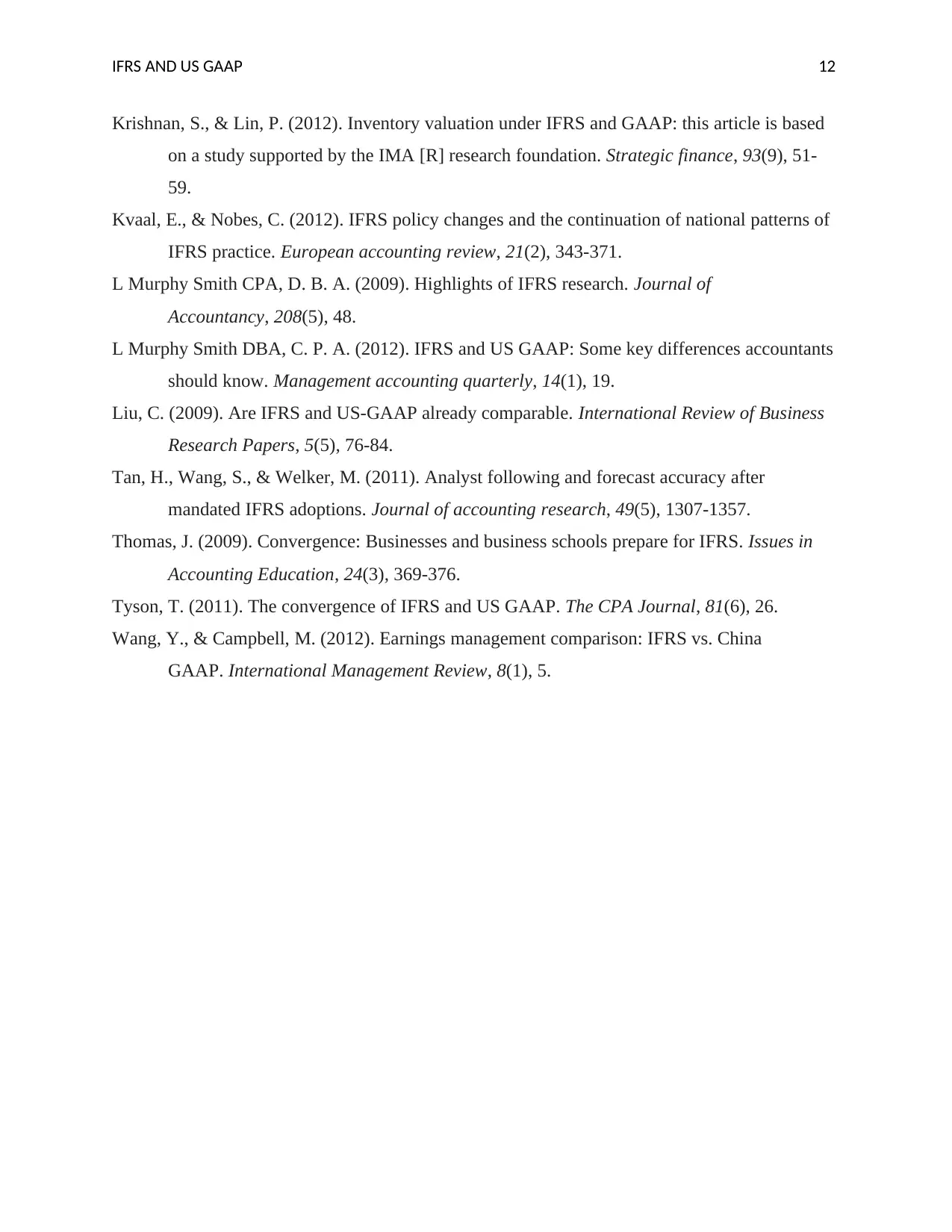
IFRS AND US GAAP 12
Krishnan, S., & Lin, P. (2012). Inventory valuation under IFRS and GAAP: this article is based
on a study supported by the IMA [R] research foundation. Strategic finance, 93(9), 51-
59.
Kvaal, E., & Nobes, C. (2012). IFRS policy changes and the continuation of national patterns of
IFRS practice. European accounting review, 21(2), 343-371.
L Murphy Smith CPA, D. B. A. (2009). Highlights of IFRS research. Journal of
Accountancy, 208(5), 48.
L Murphy Smith DBA, C. P. A. (2012). IFRS and US GAAP: Some key differences accountants
should know. Management accounting quarterly, 14(1), 19.
Liu, C. (2009). Are IFRS and US-GAAP already comparable. International Review of Business
Research Papers, 5(5), 76-84.
Tan, H., Wang, S., & Welker, M. (2011). Analyst following and forecast accuracy after
mandated IFRS adoptions. Journal of accounting research, 49(5), 1307-1357.
Thomas, J. (2009). Convergence: Businesses and business schools prepare for IFRS. Issues in
Accounting Education, 24(3), 369-376.
Tyson, T. (2011). The convergence of IFRS and US GAAP. The CPA Journal, 81(6), 26.
Wang, Y., & Campbell, M. (2012). Earnings management comparison: IFRS vs. China
GAAP. International Management Review, 8(1), 5.
Krishnan, S., & Lin, P. (2012). Inventory valuation under IFRS and GAAP: this article is based
on a study supported by the IMA [R] research foundation. Strategic finance, 93(9), 51-
59.
Kvaal, E., & Nobes, C. (2012). IFRS policy changes and the continuation of national patterns of
IFRS practice. European accounting review, 21(2), 343-371.
L Murphy Smith CPA, D. B. A. (2009). Highlights of IFRS research. Journal of
Accountancy, 208(5), 48.
L Murphy Smith DBA, C. P. A. (2012). IFRS and US GAAP: Some key differences accountants
should know. Management accounting quarterly, 14(1), 19.
Liu, C. (2009). Are IFRS and US-GAAP already comparable. International Review of Business
Research Papers, 5(5), 76-84.
Tan, H., Wang, S., & Welker, M. (2011). Analyst following and forecast accuracy after
mandated IFRS adoptions. Journal of accounting research, 49(5), 1307-1357.
Thomas, J. (2009). Convergence: Businesses and business schools prepare for IFRS. Issues in
Accounting Education, 24(3), 369-376.
Tyson, T. (2011). The convergence of IFRS and US GAAP. The CPA Journal, 81(6), 26.
Wang, Y., & Campbell, M. (2012). Earnings management comparison: IFRS vs. China
GAAP. International Management Review, 8(1), 5.
⊘ This is a preview!⊘
Do you want full access?
Subscribe today to unlock all pages.

Trusted by 1+ million students worldwide
1 out of 12
Related Documents
Your All-in-One AI-Powered Toolkit for Academic Success.
+13062052269
info@desklib.com
Available 24*7 on WhatsApp / Email
![[object Object]](/_next/static/media/star-bottom.7253800d.svg)
Unlock your academic potential
Copyright © 2020–2025 A2Z Services. All Rights Reserved. Developed and managed by ZUCOL.





